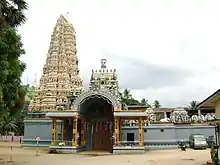Sri Muthumariamman Temple, Matale
Muthumariamman Temple (Tamil: முத்து மாரியம்மன் கோவில்) or Arulmigu Sri Muthumari Amman Kovil is a Hindu temple in Matale, Sri Lanka.[1]
| Muthumariamman Temple | |
|---|---|
ஸ்ரீ முத்துமாரியம்மன் கோவில் | |
 Muthumariamman Temple in Matale, Sri Lanka. | |
| Religion | |
| Affiliation | Hinduism |
| District | Matale District |
| Province | Central Province |
| Deity | Muthumariamman |
| Location | |
| Location | Matale |
| Country | Sri Lanka |
 Location in Sri Lanka | |
| Geographic coordinates | 7°28′35.9″N 80°37′21.4″E |
| Architecture | |
| Type | Dravidian Architecture |
| Creator | Nattukottai Nagarathar (Chettiar) |
| Completed | 1874 |
The prefix “Muthu”, literally means “pearl”. "Mari" means rain and "Amman" means mother in Tamil language.[2] The temple is dedicated to Mariamman, the goddess of rain and fertility.[3]
History
The land was originally part of a paddy field and was gifted by the owner in 1852. The current temple was built in 1874, funded by the Nattukkottai Chettiar.[4] This temple is used by both Hindus and Buddhists. The temple was originally a small statue under a tree prayed to by the Hindu people but has been developed by the people in Matale.[5]
The temple was severely damaged during the anti-Tamil riots in July 1983 but has been subsequently restored. One of the most visually dominant features of this temple is its 32.9 m (108 ft) high Gopuram ('Raja Koburum'), a large decorated tower located above the main northern gateway ('Vadakku Vaayil') to the temple. The Raja Koburum is one of the largest Gopurams in Sri Lanka. The 1008 statues of Hindu deities are the work of South Indian sculptor, Nagalingam and his son Ramanathan, with the help of about 100 designers, painters and architects from Tamil Nadu and Sri Lanka. The Raja Koburum was completed in 2007 at the cost of approximately Rs 150M.
Special events
The main religious festivals including the chariot festival at the temple are celebrated during February or March.[6][7]
The temple has five ornate chariots, which are used to convey statues of Hindu deities around the city on 'Ther' or 'Vettai Thiruvizha', the chariot ceremony day, which is held the day before 'Medin Poya' (the Poya day in March).[8]
Wedding hall
There is a large wedding hall for the Hindu people. This wedding hall has been in use from 1856 to the present.[9]
References
- "Muthumariamman Temple in Matale". Sightseeing-Lankatours. Retrieved 9 March 2017.
- Nabokov, Isabelle (21 September 2000). Religion Against the Self: An Ethnography of Tamil Rituals. Oxford University Press. ISBN 9780195354362.
- Bhattacharya, Jayati; Kripalani, Coonoor (1 March 2015). Indian and Chinese Immigrant Communities: Comparative Perspectives. Anthem Press. ISBN 9781783083626.
- Pieris, Kamalika (5 April 2016). "Hindu temples in British Ceylon". The Island. Retrieved 23 April 2017.
- "LANKALIBRARY FORUM • View topic – Arulmigu Sri Muthumari Amman Hindu Kovil". lankalibrary.com. Retrieved 1 April 2017.
- "Matale Muthumariamman temple festival". www.omlanka.net. Retrieved 9 March 2017.
- "Matale Muthumari Amman Chariot Festival". www.omlanka.net. Retrieved 1 April 2017.
- Basnayake, Richard. "Theru Festival of Arulmigu Sri Muthumari Amman Kovil, Matale". Daily News. Retrieved 9 March 2017.
- "Notable Photos: The Colors of Matale". TravelShus. 25 August 2014. Retrieved 30 April 2017.
See also
| Wikimedia Commons has media related to Muthumariamman Temple, Matale. |